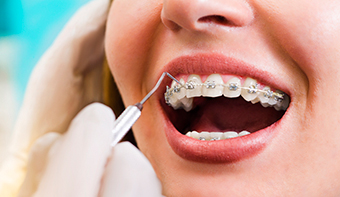 16 Jul 2022
16 Jul 2022
If you have decided to undergo orthodontic treatment, you have a major choice to make: do you want braces or Invisalign?
Both of these treatment methods have been around for many years and have proven themselves to be effective. Choosing the right one for you requires a closer look at the advantages and disadvantages of each.
Invisalign vs. Braces: Pros and Cons
Cost
Invisalign and braces usually cost around the same amount. In some cases, Invisalign treatment may be slightly more expensive. The cost of both treatments is higher when treatment is longer, highly complex, or requires one or more attachments to achieve the desired results.
Your dentist can give you an estimate for both treatments to help you work out which is best for your budget. Both treatments may be partially covered by your insurance. Some dentists may also offer financing options for orthodontic treatment to help you get the care you need without incurring financial hardship.
Appearance
Metal braces are quite noticeable and make many people who wear them self-conscious about their smile. Ceramic or lingual braces may be less noticeable, but they can still be spotted in some situations.
Invisalign trays are clear and discreet, making them a great choice if you want to undergo treatment without drawing attention to your teeth. Most people will never notice they are there, and they will not distract from your smile in pictures or in social situations.
Comfort
Traditional braces use brackets and wires to move your teeth. These elements can make them uncomfortable or even painful to wear. If a wire breaks, it may cut the inside of your mouth.
In contrast, Invisalign trays are much more comfortable to wear. These simple, clear aligners fit right over your teeth and can be worn when sleeping, speaking, and going about your daily activities. After a while, you may forget they are there at all.
Effectiveness
Both braces and Invisalign are highly effective at moving teeth. Either can be used to treat a variety of orthodontic problems, including overbite, underbite, a diastema, and more.
However, Invisalign has certain limitations that traditional braces do not. Some highly complex cases can only be treated using braces. Your treatment provider will let you know if you are not a good candidate for Invisalign treatment.
Convenience
Traditional braces are infamous for their inconvenience. They must be manually adjusted during each phase of your treatment, forcing you to make time for a visit to your dentist in Mississauga for orthodontic work regularly. Many people also need additional visits to get broken brackets and wires repaired.
Invisalign treatment is conducted using prefabricated plastic trays, so adjustments are rarely needed. Your provider will monitor your progress over the course of your treatment during brief visits every two months or so. This approach allows you to get the same quality of care with far fewer trips to the dentist’s office.
Cleaning and Maintenance
Braces require plenty of diligent care to maintain. Because they are cemented to your teeth and cannot be removed at home, you will need to brush and floss very carefully around them. This is difficult and time-consuming, but good hygiene is more important than ever when wearing braces. The wires and brackets often trap food in your mouth and may increase your risk of tooth decay without proper cleaning.
Invisalign aligners can be removed to eat, brush, and floss, making it much easier to keep both your teeth and the trays clean. It is recommended that you brush and floss after each meal to avoid trapping food between the trays and your teeth.
Follow-Up Care and Maintenance
Both braces and Invisalign require you to wear a retainer at night to maintain your results. This may feel more comfortable for Invisalign users due to how similar retainers are to the clear aligners they wore during their treatment.
People treated with either braces or Invisalign can also opt for permanent lingual retainers cemented to the backs of their teeth. This option makes it easier for patients to retain their results by making it impossible for them to remove or misplace their retainers.
Which Treatment Is Faster?
While each case is different, people treated with Invisalign tend to finish treatment sooner than those treated with braces. Some Invisalign treatments can be completed in as little as six months. Traditional braces typically take at least one year to produce results, and longer treatment times are very common.
However, adherence is key to finishing Invisalign treatment quickly. If you wear your Invisalign aligners for less than the recommended 22 hours per day, your treatment will take longer to complete. Patients who know they are likely to struggle with this may want to choose braces instead.
Which One Moves Teeth More Efficiently?
Both braces and Invisalign are excellent treatments for misaligned teeth. Which of the two is most efficient depends on how efficiency is defined.
Invisalign often produces faster tooth movements than braces do, making it the winner in terms of speed. However, braces can accomplish movements that Invisalign cannot, giving them an edge over clear aligners. Invisalign must also be worn consistently to achieve results, while braces will continue to move teeth regardless of what the patient does.
Invisalign vs. Braces: The Final Verdict
Ultimately, there is no right or wrong answer when choosing between Invisalign and braces. Both treatments have strengths and weaknesses: only you can decide which is best for you. If you have any doubts, Google “Invisalign near me” and ask your nearest provider for input. They will be happy to offer some professional advice.
For a Beautifully Aligned Smile, Choose Trillium Smile Dentistry
 Interested in undergoing Invisalign in Mississauga? Contact Trillium Smile Dentistry for a stellar experience and dazzling results. Dr. Tousi is a certified Invisalign dentist with many years of experience treating even the most complex cases. Call us today at 905-828-9894 or request an appointment online to get started on the journey toward your ideal smile.
Interested in undergoing Invisalign in Mississauga? Contact Trillium Smile Dentistry for a stellar experience and dazzling results. Dr. Tousi is a certified Invisalign dentist with many years of experience treating even the most complex cases. Call us today at 905-828-9894 or request an appointment online to get started on the journey toward your ideal smile.
Also Read:
